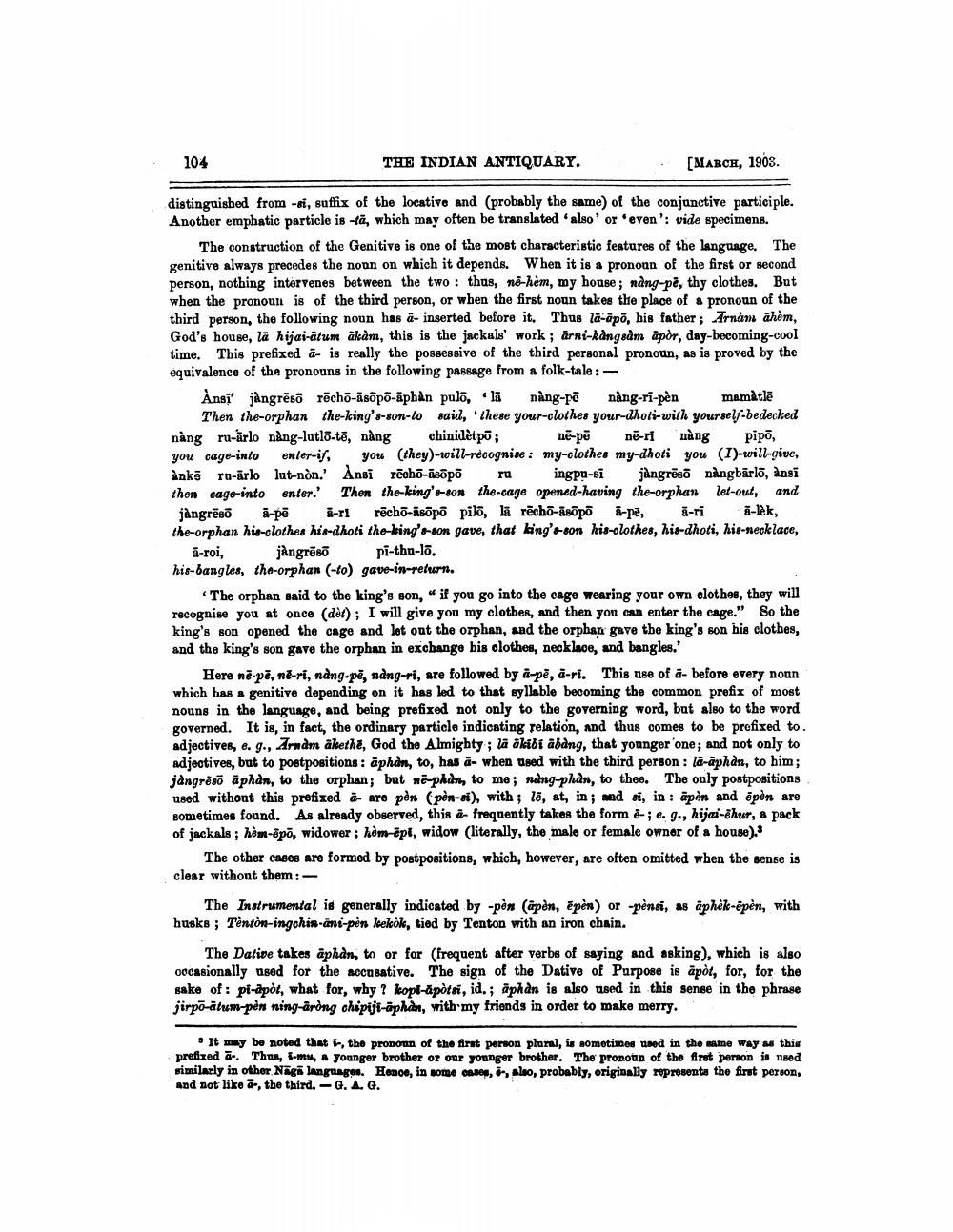________________
104
THE INDIAN ANTIQUARY.
.
[MARCH, 1908.
distinguished from -si, suffix of the locative and probably the same) of the conjunctive participle. Another emphatic particle is -tā, which may often be translated also' or even': vide specimens.
The construction of the Genitive is one of the most characteristic features of the language. The genitive always precedes the noun on which it depends. When it is a pronoun of the first or second person, nothing intervenes between the two : thus, nē-hem, my house; ndng-pë, thy clothes. But when the pronoun is of the third person, or when the first noun takes the place of a pronoun of the third person, the following noun has ā- inserted before it. Thus lä-āpo, his father ; Arnam āhèm, God's house, la hijai-atum akàm, this is the jackals' work; arni-kangsdm apor, day-becoming-cool time. This prefixed a- is really the possessive of the third personal pronoun, as is proved by the equivalence of the pronouns in the following passage from a folk-tale: -
Angi jAngrẽsố rếchô-äsôpô-ãphàn pulô, lũ nàng-pô nàng-ri-pen mamatlẽ
Then the-orphan the king's-son-to said, these your clothes your-dhoti-with yourself-bedecked nàng ru-ärlo nàng-lutlô-tô, nàng chinidẹtpõ; nế-pẽ nê-ri nàng pipõ, you cage-into enter-if, you (they)-will-recognise : my-clothes my-dhoti you (1)-will-give, Ankẽ ru-ữrlo lat-nòn. Ansi rẽch6-886põ ra ingia-si jangresô nàngbarlô, Ansĩ then cage-into enter.' Then the king's-8on the-cage opened-having the-orphan let-out, and
jàngrëső X-pē ā-ri rēcho-āsāpā pilo, lā rēcb7-asõpā ā-pe, a-ri a -lèk, the-orphan his-olothes his-dhoti the-being's son gave, that king's-son his clothes, his-dhori, his-necklace,
a-roi, jàngrēsā pi-thu-lo. his-bangles, the-orphan (-to) gave-in-return.
The orphan said to the king's son, if you go into the cage wearing your own clothes, they will recognise you at once (det); I will give you my clothes, and then you can enter the cage." So the king's son opened the cage and let out the orphan, and the orphan gave the king's son his clothes, and the king's son gave the orphan in exchange bis clothes, necklace, and bangles.'
Here ne-pē, nē-ri, ndng-pë, ndng-ri, are followed by a pē, ā-ri. This use of a- before every noun which has a genitive depending on it has led to that syllable becoming the common prefix of most nouns in the language, and being prefixed not only to the governing word, but also to the word governed. It is, in fact, the ordinary particle indicating relation, and thus comes to be prefixed to. adjectives, e. g., Arnom åketha, God the Almighty ; la ökibi abang, that younger 'one; and not only to adjectives, but to postpositions : aphan, to, has a- when used with the third person : la-āphan, to him; jangrēsā aphan, to the orphan; but ne-phan, to me; nang-phan, to thee. The only postpositions used without this prefixed å are pèn (pen-s), with ; lē, at, in; and si, in: apen and ēpèn are Bometimes found. As already observed, this a- frequently takes the form -; e. 9., hijai-zhur, a pack of jackals; hom-opā, widower; hòm-öpt, widow (literally, the male or female owner of a house)
The other cases are formed by postpositions, which, however, are often omitted when the sense is clear without them :
The Instrumental is generally indicated by -pen (@pen, épèn) or -pensi, as äphèk-epèn, with husks ; Tentòn-ingchin-ani-pen kekok, tied by Tenton with an iron chain.
The Dative takes aphan, to or for (frequent after verbs of saying and asking), which is also occasionally used for the accusative. The sign of the Dative of Purpose is apòt, for, for the sake of : pi-apot, what for, why ? kopt-apotsi, id. ; āphan is also used in this sense in the phrase jirpo-ātum-pèn ning-aròng chipiji-āphan, with my friends in order to make merry.
* It may be noted that the pronoun of the first person plural, is sometimes used in the same way as this prefized ... Thus, -ma, a younger brother or our younger brother. The pronoun of the first person is used similarly in other Näga language. Honoe, in some cases, also, probably, originally represents the first person, and not like ā-, the third. - G.A.G.




